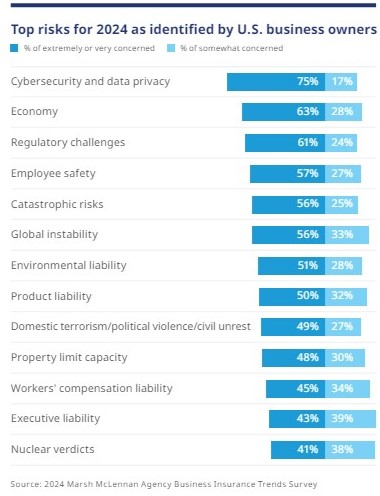Business leaders place cybersecurity, the economy, regulatory challenges and global instability among their top concerns for the coming year, fueled by factors such as AI, climate change, nuclear verdicts and political unrest.
The annual Marsh McLennan Agency Business Insurance Trends report offers insights into the evolving risk landscape experienced by middle-market business leaders across the United States.
Top risks for 2024 as identified by U.S. business owners include:
Ninety-two percent of survey participants said they have high to medium engagement with risk management decisions and strategies within their organization.
Cybersecurity and AI
While 52% of leaders said tech advancements like AI, advanced imaging, data analytics, automation and more will lead to new challenges for their business, 93% of them also said it would lead to new opportunities. For example, integrating AI technologies can significantly enhance an organization’s ability to detect, respond to, and mitigate cyber threats more effectively. But, at the same time, risks can include the emergence of AI-driven attacks and the inadvertent release of sensitive information when data is shared with third parties.
Regulatory risks
Key themes of improving the employee experience, data privacy and business accountability are pervasive across the 2024 compliance landscape. Examples gaining momentum include worker classification, Biometric Information Privacy Act (BIPA) laws, regulatory frameworks to enhance environmental transparency and accountability and workers’ compensation presumptions.
Workforce risk
New ways of working, changing worker expectations, and expanding regulations have created an unpredictable talent market. Only 34% of business leaders surveyed believe their organization is well-prepared to manage gaps effectively. Small and mid-sized businesses face challenges related to the expanding regulatory and compliance requirements around workforce safety and absence, disability and leave (ADL) benefit regulations. Worker safety and satisfaction hinge on established processes and procedures that reduce incidences and turnover.
Catastrophic weather risks and property limit capacity
Rising exposure from secondary perils, the increasing number of climate events resulting in $1 billion losses or more and urbanization in riskier areas will continue to define a “new normal.”
Swiss Re Institute analyzed 2023 natural catastrophes and found global economic losses totaling $280 billion. Of these, $108 billion (40%) were covered by insurance, above the previous 10-year average of $89 billion. Swiss Re also stated that claims costs have risen by approximately 30% since 2020, signaling that organizations need to double down to reduce their loss potential.
Companies can minimize exposures by understanding risks, using catastrophe modeling, conducting a comprehensive assessment of insurance coverages and gaps, and following insurer recommendations. Long-term solutions will require a commitment to systemic changes and adaptations to evolving risks.
Nuclear verdicts and social inflation
From 2010 to 2019, the average award for general liability verdicts increased by 224%. The cost of corporate nuclear verdicts nearly quadrupled after that, from $4.9 billion in 2020 to over $18.3 billion in 2022. Increases are attributed to strategic litigation tactics, sympathetic juries, increased availability of funding for litigation, and third-party litigators providing financial support to plaintiffs
The ripple effects of nuclear verdicts impact insurance premiums, C-suite and shareholder confidence and a business’s bottom line.
To address inflation, underwriters review contracts more thoroughly, and industries that work closely with third parties or subcontractors review agreements more carefully to ensure enough protection exists between parties. Robust risk management practices, such as developing processes to anticipate potentially harmful claims and building relationships with risk mitigation experts, can help bolster protection against nuclear verdicts.
Global instability
The pervasive effects of geopolitical uncertainties are increasingly at the forefront of business owners’ concerns. The upcoming year is the largest global election year in history, making misinformation and disinformation one of the most concerning global risks anticipated over the next two years.
Global instability leads to the potential and likelihood of supply chain disruptions, market volatility, regulatory changes and political risk. The instability of global economic conditions, such as recessions and inflation, can also affect consumer spending patterns and investment decisions.
Topics Trends Cyber Legislation Commercial Lines Business Insurance Leadership
Was this article valuable?
Here are more articles you may enjoy.




 Changes at American Coastal Insurance After Florida OIR Action on ‘No-Fly List’
Changes at American Coastal Insurance After Florida OIR Action on ‘No-Fly List’  Big ‘I’ Report: Independent Agency Channel Placed 62% of Premiums in 2023
Big ‘I’ Report: Independent Agency Channel Placed 62% of Premiums in 2023  US P/C Insurers Post Best Q1 Underwriting Result In 17 Years
US P/C Insurers Post Best Q1 Underwriting Result In 17 Years  Supreme Court Overturns Chevron Rule in Blow to Regulators
Supreme Court Overturns Chevron Rule in Blow to Regulators 

